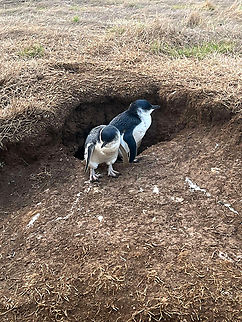
Appearance
Like those of all penguins, the little penguin's wings have developed into flippers used for swimming. The Little Penguin typically grows to between 30 and 33 cm tall and usually weighs about 1.5 kilogram on average. The head and upperparts are blue in colour, with slate-grey ear coverts fading to white underneath, from the chin to the belly. The flippers are blue. The dark grey-black beak is 3–4 cm long, the irises pale silvery- or bluish-grey or hazel, and the feet pink above with black soles and webbing. An immature individual will have a shorter bill and lighter upperparts.Like most seabirds, they have a long lifespan. The average for the species is 6.5 years, but flipper ringing experiments show in very exceptional cases up to 25 years in captivity.
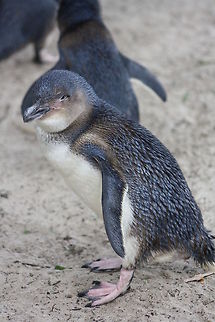
Naming
Apart from Little Penguins, they have several common names. In Australia, they are also referred to as Fairy Penguins because of their tiny size. In New Zealand, they are also called Little Blue Penguins, or just Blue Penguins, owing to their slate-blue plumage, and they are called Kororā in Māori.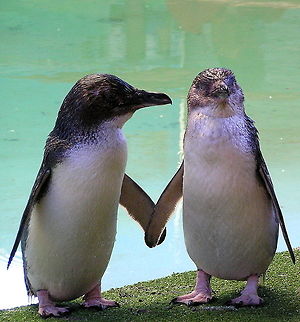
Distribution
The Little Penguin breeds along the entire coastline of New Zealand, the Chatham Islands, and southern Australia.Little penguins have also been reported from Chile and South Africa, but it is unclear whether these birds were vagrants.
Rough estimates of the world population are around 350,000-600,000 animals. The species is not considered endangered, except for the White-Flippered subspecies found only on Banks Peninsula and nearby Motunau Island in New Zealand. Since the 1960s, the mainland population has declined by 60-70%; though there has been a small increase on Motunau Island. But overall Little Penguin populations have been decreasing as well, with some colonies having been wiped out and other populations continuing to be at risk. However, new colonies have been established in urban areas.
The greatest threat to Little Penguin populations has been predation from cats, foxes, large reptiles, ferrets and stoats. Due to their diminutive size and the introduction of new predators, some colonies have been reduced in size by as much as 98% in just a few years, such as the small colony on Middle Island, near Warrnambool, Victoria, which was reduced from 5000 penguins to 100. Because of this threat of colony collapse, conservationists pioneered an experimental technique using Maremma Sheepdogs to protect the colony and fend off would-be predators.
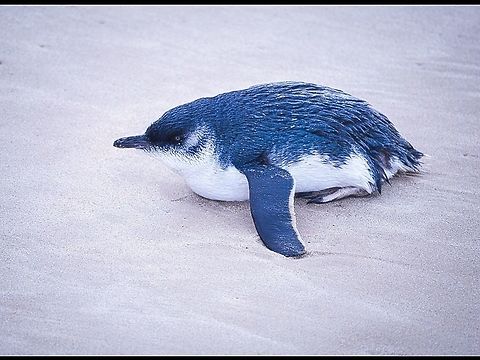
Behavior
Like Galápagos penguins, Little Penguins spend the whole day swimming in the sea. They are out at sunrise and hunt into the evening. Little Penguins preen their feathers to keep them waterproof. They do this by rubbing a tiny drop of oil onto every feather from a special gland above the tail.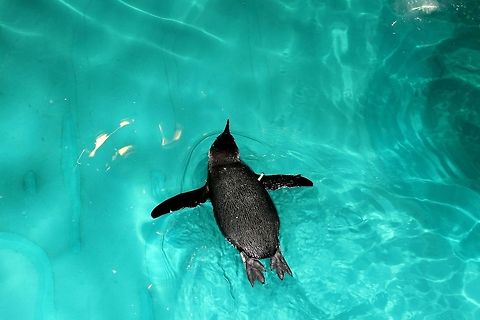
Reproduction
Little Penguins mature at different ages. The female matures at 2 years old. The male, however, matures at 3 years old. Little Penguins only remain faithful to their partner in breeding seasons and whilst hatching eggs. At other times of the year they do tend to swap burrows. They exhibit site fidelity to their nesting colonies and nesting sites over successive years.Little Penguins live year-round in large colonies, with each individual breeding pair forming a burrow in which to raise their chicks. Little Penguins typically return to their colonies to feed their chicks at dusk. The birds will tend to come ashore in small groups to provide some defense against predators which might pick off individuals one by one. In Australia, the strongest colonies are usually on cat-free and fox-free islands. However, the population on Granite Island has been severely depleted, from around 2000 penguins in the year of 2001 down to 146 in 2009.
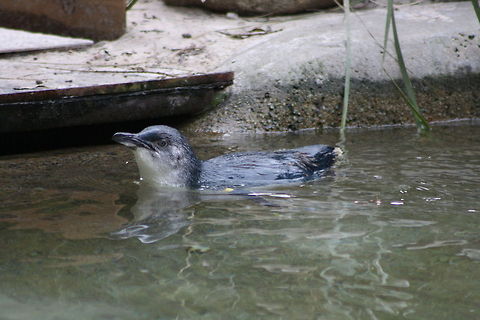
Food
These birds feed by hunting fish, squid and other small sea animals, for which they travel and dive quite extensively. They are generally inshore feeders. The use of data loggers has provided information of the diving behavior of Little Penguins. 50% of their dives go no deeper than 2 m and the mean diving time is 21 seconds. Yet, they are able to dive as deep as 20m and remained submerged as long as 60 sec.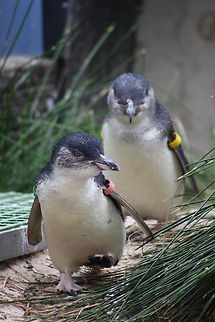
Predators
Little Penguins in the wild are sometimes preyed upon by New Zealand fur seals. A study done by researchers from the South Australian Research and Development Institute found that roughly 40 percent of seal droppings in South Australia's Granite Island area contained Little Penguin remains....hieroglyph snipped...Little Penguins on Middle Island in Warrnambool, Victoria were subject to heavy predation by foxes, which could reach the island at low tide by a tidal sand bridge. The deployment of Maremma sheepdogs to protect the penguin colony has deterred the foxes and enabled the penguin population to rebound. This is in addition to the support from groups of volunteers who work to protect the penguins from attack at night.
In Sydney, snipers have been deployed to protect a colony of Little Penguins. This effort is in addition to support from local volunteers who work to protect the penguins from attack at night.
References:
Some text fragments are auto parsed from Wikipedia.